
Asteroids is a space-themed multidirectional shooter arcade video game designed by Lyle Rains and Ed Logg released in November 1979 by Atari, Inc. The player controls a single spaceship in an asteroid field which is periodically traversed by flying saucers. The object of the game is to shoot and destroy the asteroids and saucers, while not colliding with either, or being hit by the saucers' counter-fire. The game becomes harder as the number of asteroids increases.

Centipede is a 1981 fixed shooter arcade video game developed and published by Atari, Inc. Designed by Dona Bailey and Ed Logg, it was one of the most commercially successful games from the golden age of arcade video games and one of the first with a significant female player base. The primary objective is to shoot all the segments of a centipede that winds down the playing field. An arcade sequel, Millipede, followed in 1982.

Defender is a horizontally scrolling shooter developed by Williams Electronics in 1980 and released as an arcade video game in 1981. The game is set on either an unnamed planet or city where the player must defeat waves of invading aliens while protecting astronauts. Development was led by Eugene Jarvis, a pinball programmer at Williams; Defender was Jarvis's first video game project and drew inspiration from Space Invaders and Asteroids. Defender was demonstrated in late 1980, before entering production in early 1981. It was distributed in Japan by Taito.
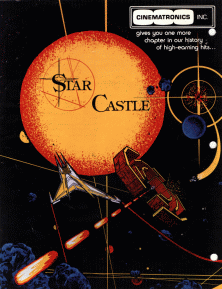
Star Castle is a vector graphics multidirectional shooter released in arcades by Cinematronics in 1980. The game involves obliterating a series of defenses orbiting a stationary turret in the center of the screen. The display is black and white with the colors of the rings and screen provided by a transparent plastic screen overlay.
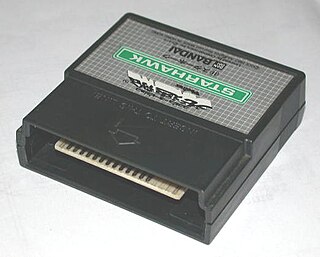
Starhawk is a 1979 vector arcade game designed and programmed by Tim Skelly and manufactured by Cinematronics. Starhawk is a shoot 'em up unofficially based on the Star Wars: Episode IV trench run, one of the first arcade games to blatantly use concepts from Star Wars. The game was unique at the time for its pseudo-3D graphics. It was distributed in Japan by Sega, and was later ported for the Vectrex home system in 1982.

Cinematronics Incorporated was an arcade game developer that primarily released vector graphics games in the late 1970s and early 1980s. While other companies released games based on raster displays, early in their history, Cinematronics and Atari, Inc. released vector-display games, which offered a distinctive look and a greater graphic capability, at the cost of being only black and white (initially). Cinematronics also published Dragon's Lair in 1983, the first major LaserDisc video game.
Fueled by the previous year's release of the colorful and appealing Pac-Man, the audience for arcade video games in 1981 became much wider. Pac-Man influenced maze games began appearing in arcades and on home systems. Pac-Man was the highest grossing video game for the second year in a row. Nintendo's Donkey Kong defined the platform game genre, while Konami's Scramble established scrolling shooters. The lesser known Jump Bug combined the two concepts into both the first scrolling platform game and the first platform shooter. Other arcade hits released in 1981 include Defender, Frogger, and the Galaxian sequel Galaga.
1980 saw the release of a number of games with influential concepts, including Pac-Man, Battlezone, Crazy Climber, Mystery House, Missile Command, Phoenix, Rally-X, Space Panic, Stratovox, Zork, Adventure, and Olympic Decathlon. The year's highest-grossing video game was Namco's arcade game Pac-Man, while the best-selling home system was Nintendo's Game & Watch. The Atari VCS also grew in popularity with a port of Space Invaders and support from new third-party developer Activision.
1979 saw many sequels and prequels in video games, such as Space Invaders Part II and Super Speed Race, along with new titles such as Asteroids, Football, Galaxian, Head On, Heiankyo Alien, Monaco GP, Sheriff and Warrior. For the second year in a row, the highest-grossing video game was Taito's arcade game Space Invaders and the best-selling home system was the Atari Video Computer System.
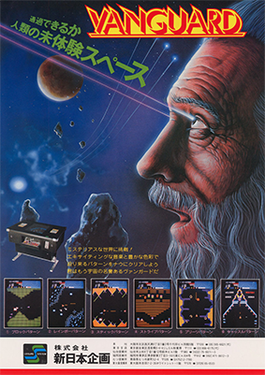
Vanguard is a scrolling shooter arcade video game developed by TOSE. It was released by SNK in Japan and Europe 1981, and licensed to Centuri for manufacture in North America in October and to Zaccaria in Italy the same year. Cinematronics converted the game to cocktail arcade cabinets in North America.

Space Panic is a 1980 arcade video game developed by Universal. Predating Nintendo's Donkey Kong, and lacking a jump mechanic, Space Panic was the first game involving climbing ladders between walkable platforms. The genre was initially labeled "climbing games", but later became known as platform games. A ColecoVision port by CBS Electronics was released in the winter holiday season of 1982.
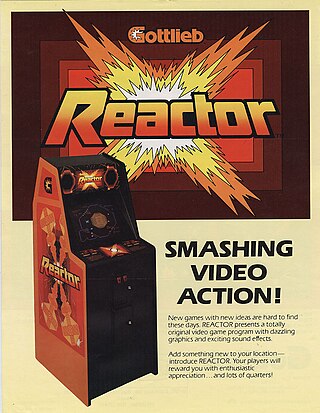
Reactor is an arcade video game released in 1982 by Gottlieb. The object of the game is to cool down the core of a nuclear reactor without being pushed into its walls by swarms of subatomic particles. Reactor was developed by Tim Skelly, who previously designed and programmed a series of vector graphics arcade games for Cinematronics, including Rip Off. It was the first arcade game to credit the developer on the title screen. Reactor was ported to the Atari 2600 by Charlie Heath and published by Parker Brothers the same year as the original.

Armor Attack is a multidirectional shooter designed by Tim Skelly and released as an arcade video game by Cinematronics in 1980. It was licensed to Sega for release in Japan and also to Rock-Ola. The vector graphics of Armor Attack present combat between the player's jeep and enemy vehicles in an overhead, maze-like view of a town. The buildings are not drawn in the game, but are an overlay that sits on top of the monitor. The overlay also tints the vectors green.
Tim Skelly was a video game designer and game programmer who developed arcade games for Cinematronics from 1978 until 1981. He designed a series of pure action games using black and white vector graphics. One of his early games, Rip Off, was the first arcade game with two-player cooperative play. Star Hawk, Rip Off, Armor Attack, and Star Castle were all later ported to the Vectrex home system.
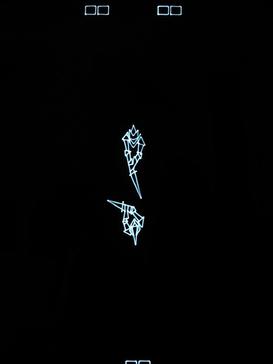
Warrior is a 1979 arcade fighting game. It is considered one of the first fighting games, excepting several boxing games such as Heavyweight Champ, released in 1976, and Atari's unreleased Boxer.
Vectorbeam was an arcade game manufacturer active in the late 1970s who specialized in vector graphics-based arcade games. It was formed after splitting off from its primary competitor, Cinematronics, and disappeared after re-merging with them soon after.

Solar Quest is a monochrome vector arcade game created by Cinematronics in 1981. It was designed and programmed by Scott Boden, who previously worked on Star Castle. It had a home release for the Vectrex system in 1982.

Zaccaria was an Italian manufacturer of pinball and arcade machines that operated in Bologna from 1974 until 1990. The factory was sold to tecnoplay.

Bug Attack is a fixed shooter video game written by Jim Nitchals for the Apple II and published by Cavalier Computer in 1981. A version for Atari 8-bit computers was released in 1982. Bug Attack is based on Atari, Inc.'s Centipede arcade game.














